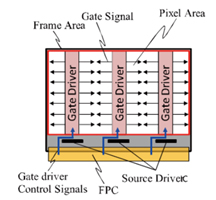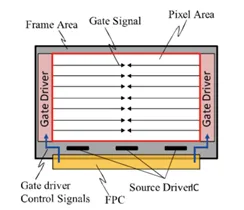For some time, Sharp has been showing examples of its “free-form” displays, which do both the “row” and “column” driving through one edge of the display, leaving the rest of the display to be cut in curves or other unusual shapes.

But Sharp had not been willing to describe in detail how it distributed the gate drivers throughout the display so that no conventional row drivers mounted on a vertical display edge are necessary.
At the most recent SID Display Week held in San Jose in early June, that changed. In the Sharp booth, Automotive Marketing Director for Display Products Thomas Spears did his best to explain the innovation, but it was hard for him to do so in any detail amidst the cut and thrust on the show floor. More detail was available from the invited paper by Hidefumi Yoshida and 13 colleagues from Sharp in Nara, Japan. The paper, “Flexible Flat-Panel Display Designs with Gate Driver Circuits Integrated within the Pixel Area”, described Sharp’s truly clever approach.
Conventional display with gate driver circuits located in bezel area (Graphic: Yoshida et al.)Yoshida and friends began with a well-known technology, gate driver monolithic circuitry (GDM). With GDM, the shift registers and output transistors of the gate drivers are deposited on the vertical edge of the display at the same time as the switching transistors are fabricated. This is an alternative to the more conventional approach of using ICs for the gate driver circuitry. Since GDM circuitry can occupy significant real estate on the vertical edge of the display, especially when implemented in amorphous silicon, it requires a wide bezel, which is not compatible with current display preferences or with gracefully curved display contours.
 Sharp display with gate drivers integrated within the pixel area. (Graphic: Yoshida et al.)Here’s where Sharp’s cleverness comes into play. First, instead of putting the GDM circuitry on the vertical edge(s) of the display, Sharp locates it in one or more vertical “bands” within the display area. I’ve put “bands” in quotes because Sharp has done far more than simply shifting the left-edge circuitry into the image area as a block. Sharp also disperses the transistors of the GDM circuitry so individual transistors are located at separate pixel locations and interconnected via additional surface connections and a large number of through holes. Thus, the gate driver control signals enter through the bottom edge of the display, which is also where the source drive ICs are located. The gate signals travel from the dispersed GDM circuits horizontally to pixels, but entirely within the image area. This allows the left, right, and top edges of the display to have very thin bezels, which can be shaped with great freedom. Sharp has shown a triple-curve display that is appropriate for the tachometer, speedometer and combined temperature/gas gauge in a primary automotive instrument display.
Sharp display with gate drivers integrated within the pixel area. (Graphic: Yoshida et al.)Here’s where Sharp’s cleverness comes into play. First, instead of putting the GDM circuitry on the vertical edge(s) of the display, Sharp locates it in one or more vertical “bands” within the display area. I’ve put “bands” in quotes because Sharp has done far more than simply shifting the left-edge circuitry into the image area as a block. Sharp also disperses the transistors of the GDM circuitry so individual transistors are located at separate pixel locations and interconnected via additional surface connections and a large number of through holes. Thus, the gate driver control signals enter through the bottom edge of the display, which is also where the source drive ICs are located. The gate signals travel from the dispersed GDM circuits horizontally to pixels, but entirely within the image area. This allows the left, right, and top edges of the display to have very thin bezels, which can be shaped with great freedom. Sharp has shown a triple-curve display that is appropriate for the tachometer, speedometer and combined temperature/gas gauge in a primary automotive instrument display.
This is a significant innovation in display architecture that is, as Yoshida et al. carefully note, just as applicable to OLED displays as to LCDs. Sharp’s Thomas Spears said there was very significant interest in the displays from automobile manufacturers, and that Sharp was seriously engaged with all of them. We will see these displays in (or as) auto instrument clusters but, given automobile design cycles, probably not until 2017. – Ken Werner

